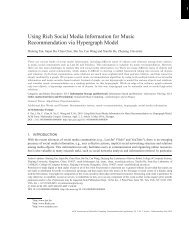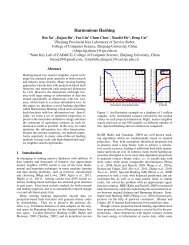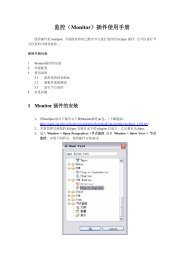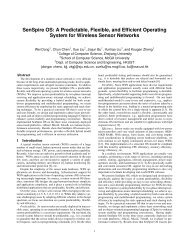Secure and Efficient Handover Authentication Based ... - IEEE Xplore
Secure and Efficient Handover Authentication Based ... - IEEE Xplore
Secure and Efficient Handover Authentication Based ... - IEEE Xplore
Create successful ePaper yourself
Turn your PDF publications into a flip-book with our unique Google optimized e-Paper software.
48 <strong>IEEE</strong> TRANSACTIONS ON WIRELESS COMMUNICATIONS, VOL. 11, NO. 1, JANUARY 2012<br />
<strong>Secure</strong> <strong>and</strong> <strong>Efficient</strong> H<strong>and</strong>over <strong>Authentication</strong><br />
<strong>Based</strong> on Bilinear Pairing Functions<br />
Daojing He, Student Member, <strong>IEEE</strong>, Chun Chen, Member, <strong>IEEE</strong>, Sammy Chan, Member, <strong>IEEE</strong>,<br />
<strong>and</strong> Jiajun Bu, Member, <strong>IEEE</strong><br />
Abstract—Seamless h<strong>and</strong>over over multiple access points is<br />
highly desirable to mobile nodes, but ensuring security <strong>and</strong> efficiency<br />
of this process is challenging. This paper shows that prior<br />
h<strong>and</strong>over authentication schemes incur high communication <strong>and</strong><br />
computation costs, <strong>and</strong> are subject to a few security attacks.<br />
Further, a novel h<strong>and</strong>over authentication protocol named Pair-<br />
H<strong>and</strong> is proposed. PairH<strong>and</strong> uses pairing-based cryptography to<br />
secure h<strong>and</strong>over process <strong>and</strong> to achieve high efficiency. Also, an<br />
efficient batch signature verification scheme is incorporated into<br />
PairH<strong>and</strong>. Experiments using our implementation on laptop PCs<br />
show that PairH<strong>and</strong> is feasible in real applications.<br />
Index Terms—Wireless networks, security, privacy, efficiency,<br />
h<strong>and</strong>over authentication.<br />
I. INTRODUCTION<br />
NOWADAYS, wireless internet access services are offered<br />
through interconnected mobile telecommunication networks,<br />
WLANs, vehicular ad hoc networks (VANETs). To<br />
overcome the geographical coverage limit of each access point<br />
<strong>and</strong> provide seamless access service for mobile nodes (e.g.,<br />
PDA, laptop PC, smart phone <strong>and</strong> vehicle), it is important to<br />
have an efficient h<strong>and</strong>over protocol. One important module in<br />
the h<strong>and</strong>over protocol is authentication. Regardless of the technology<br />
implemented, as shown in Fig. 1, a typical h<strong>and</strong>over<br />
authentication scenario involves three entities: mobile nodes<br />
(MNs), access points (APs) <strong>and</strong> the authentication server (AS).<br />
Before entering the network, an MN registers to AS, then subscribes<br />
services <strong>and</strong> connects to an AP for accessing the network.<br />
When the MN moves from the current AP (e.g.,
HE et al.: SECURE AND EFFICIENT HANDOVER AUTHENTICATION BASED ON BILINEAR PAIRING FUNCTIONS 49<br />
[12]. Unfortunately, it is not efficient in communication,<br />
because the certificate has to be transmitted along with the<br />
digital signature as the message propagates in the network.<br />
This leads to more energy consumption on MNs. Moreover, to<br />
authenticate each digital signature, the corresponding receiver<br />
always takes two expensive signature verification operations.<br />
This is because the certificate needs to be authenticated as<br />
well. (4) To provide user anonymity, group signature-based<br />
protocols have been proposed in [11], [12]. However, the user<br />
revocation list needs to be distributed across the entire network<br />
in a timely manner. Further, the verification delay incurred in<br />
these protocols for each access request is linearly proportional<br />
to the number of revoked users. Therefore, the performance of<br />
these protocols may deteriorate when the number of revoked<br />
users is large. (5) Generally, an AP verifies each signature<br />
individually. When the arrival rate of signatures is high, a<br />
scalability problem emerges immediately, where the AP has<br />
much less time to verify each received signature. For example,<br />
in VANETs, each RSU could possibly communicate with<br />
hundreds of OBUs, each sending a safety related message to<br />
the RSU every 100-300 ms [14].<br />
Second, security <strong>and</strong> privacy are serious concerns for the<br />
h<strong>and</strong>over authentication service. However, all existing h<strong>and</strong>over<br />
authentication protocols [1]–[12] are subject to a few<br />
security attacks in two aspects. On the one h<strong>and</strong>, users are<br />
deeply concerned about their privacy-related information such<br />
as the identity, position, <strong>and</strong> roaming route. Unfortunately, in<br />
most of the current h<strong>and</strong>over authentication schemes (e.g., [1]–<br />
[5], [7]–[10]), it is commonly assumed that the APs are<br />
trustworthy <strong>and</strong> would keep users’ privacy-related information<br />
confidential. However, since such information is extremely<br />
sensitive <strong>and</strong> coveted by many companies, which may use it to<br />
improve their business, such an assumption may not be valid.<br />
Therefore, a user should be protected from the prying eyes of<br />
APs. On the other h<strong>and</strong>, by Denial-of-Service (DoS) attacks,<br />
adversaries can exhaust the resources of AP <strong>and</strong> AS <strong>and</strong> render<br />
them less capable of serving legitimate MNs. Such attacks can<br />
be classified into two categories. (1) The conventional way of<br />
performing h<strong>and</strong>over authentication [1]–[6] requires an AP to<br />
unconditionally forward any access request, valid or invalid, to<br />
AS, an adversary can easily launch DoS attacks on AS through<br />
an AP. (2) To avoid such a DoS attack, some recent h<strong>and</strong>over<br />
authentication techniques (e.g., [7]–[12]) only require an MN<br />
<strong>and</strong> an AP to be involved in each protocol run. However,<br />
the AP needs to perform expensive cryptographic operations<br />
(e.g., pairing computation in [11], [12]) to check the validity<br />
of the sender. This checking is exploited by the adversary<br />
to make another type of DoS attack. That is, it can inject<br />
bogus access requests into the networks, force the APs that<br />
receive such messages to perform expensive verifications, <strong>and</strong><br />
eventually exhaust their resources. Despite the necessity <strong>and</strong><br />
importance, no research has been conducted to address this<br />
attack in h<strong>and</strong>over authentication.<br />
According to the above analysis, all existing h<strong>and</strong>over<br />
authentication protocols fail to provide appropriate security<br />
<strong>and</strong> efficiency guarantees. In this case, users are reluctant to<br />
accept such mobile service. Thus, it is utterly important to provide<br />
an efficient h<strong>and</strong>over authentication protocol for practical<br />
wireless networks. In this paper, we propose a novel h<strong>and</strong>over<br />
authentication protocol called PairH<strong>and</strong>, which uses pairingbased<br />
cryptography to secure h<strong>and</strong>over process <strong>and</strong> to reduce<br />
the communication <strong>and</strong> computation overheads of the involved<br />
entities. Also, it only requires two h<strong>and</strong>shakes between an<br />
MN <strong>and</strong> an AP, <strong>and</strong> does not need to transmit or verify any<br />
certificate as in traditional public key cryptosystems. Further,<br />
we introduce an efficient batch signature verification scheme,<br />
in which each AP can simultaneously verify multiple received<br />
signatures.<br />
The remainder of this paper is organized as follows. Section<br />
II discusses the security requirements <strong>and</strong> bilinear maps.<br />
Section III presents our protocol <strong>and</strong> Section IV analyzes <strong>and</strong><br />
evaluates the protocol. Section V concludes the paper.<br />
II. SECURITY REQUIREMENTS AND PRELIMINARIES<br />
A. Security Requirements<br />
As reported in [9]–[12], a strong h<strong>and</strong>over authentication<br />
should satisfy the following seven security properties: (1)<br />
Subscription validation: An AP must authenticate MNs to<br />
ensure their legitimacy. (2) Server authentication: MNs should<br />
be allowed to authenticate the AP they visit to avoid potential<br />
deception <strong>and</strong> other malicious attacks. (3) Key establishment:<br />
A session key should be established between an MN <strong>and</strong><br />
an AP to protect subsequent exchanged data between them.<br />
(4) User anonymity <strong>and</strong> untraceability: Except to AS, the<br />
user is anonymous <strong>and</strong> his activities are unlinkable to anyone<br />
including the visited AP. (5) Conditional privacy preservation:<br />
In some application scenarios, it is the liability for AS to reveal<br />
the related private information (e.g., identity, position) of an<br />
MN to law enforcement in case of emergency (e.g., enhanced<br />
911 location service m<strong>and</strong>ated by U.S. Federal Communications<br />
Commission). (6) Provision of user revocation: Service to<br />
an MN should be terminated once his subscription period ends.<br />
(7) Attack-resistance: The protocol should have the ability to<br />
resist the attacks in wireless networks (i.e., replay <strong>and</strong> DoS<br />
attacks) such that it can be applied in the real world.<br />
B. Bilinear Maps<br />
Let
50 <strong>IEEE</strong> TRANSACTIONS ON WIRELESS COMMUNICATIONS, VOL. 11, NO. 1, JANUARY 2012<br />
signature, ring signature, <strong>and</strong> group signature techniques, suits<br />
our purpose given the security <strong>and</strong> efficiency requirements<br />
discussed above. Blind signature <strong>and</strong> ring signature can only<br />
provide unconditional privacy, while PairH<strong>and</strong> dem<strong>and</strong>s conditional<br />
privacy, <strong>and</strong> hence, revocable anonymity. Existing<br />
group signature schemes do provide revocable anonymity,<br />
but cannot meet high efficiency as described in Section I.<br />
Here we adopt the privacy preserving technique based on<br />
pseudonyms. Since MNs generally have large storage capacity,<br />
rendering the preloading of a large pool of pseudonyms from<br />
AS feasible. A recent work [16] quantitatively studied the<br />
storage space requirement for preloading anonymous keys<br />
(i.e., pseudonyms) <strong>and</strong> associated certificates for long term use<br />
(i.e., one year). Their results are obtained based on quantifying<br />
the upper <strong>and</strong> lower bounds on the pseudonym change interval<br />
for maintaining a satisfactory degree of privacy. Since the<br />
preloading method in our h<strong>and</strong>over authentication protocol<br />
involves a pool of shorter-lived pseudonyms, the memory<br />
consumption is bounded by the results given by [16]. The<br />
preload-<strong>and</strong>-replenish mechanism has been proposed by many<br />
researchers <strong>and</strong> works efficiently. For example, it can be<br />
realized through some existing wireless infrastructure, such<br />
as Wi-Fi networks.<br />
A. System Initialization<br />
In system initialization phase, AS first initializes the whole<br />
system by running the following steps. Let
HE et al.: SECURE AND EFFICIENT HANDOVER AUTHENTICATION BASED ON BILINEAR PAIRING FUNCTIONS 51<br />
Fig. 2. The protocol run of PairH<strong>and</strong>.<br />
Therefore, the computation cost by the AP for verifying<br />
a single signature is dominantly comprised of 1 point multiplication<br />
<strong>and</strong> 2 pairing operations. Note that the computation<br />
cost of a pairing operation is higher than the cost of a point<br />
multiplication operation.<br />
5) Finally, AP2 securely transmits {ℳ
52 <strong>IEEE</strong> TRANSACTIONS ON WIRELESS COMMUNICATIONS, VOL. 11, NO. 1, JANUARY 2012<br />
TABLE I<br />
FUNCTIONALITY AND PERFORMANCE COMPARISON BETWEEN PAIRHAND AND RELATED WORK<br />
ME: modular exponentiation, RV : RSA verification<br />
Protocols Number of User Anonymity Conditional Privacy DoS Attack Commun. User Cryptographic
HE et al.: SECURE AND EFFICIENT HANDOVER AUTHENTICATION BASED ON BILINEAR PAIRING FUNCTIONS 53<br />
verification delay in msec<br />
1400<br />
1200<br />
1000<br />
800<br />
600<br />
400<br />
200<br />
TABLE III<br />
TIMINGS FOR EVALUATING A













